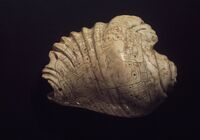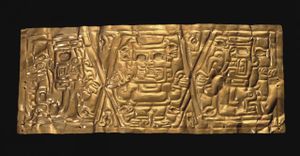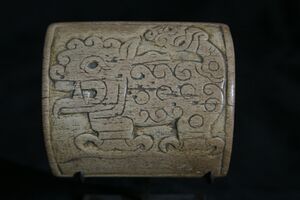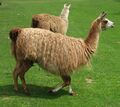تشاڤين (ثقافة)
حضارة چاڤين چاڤين Chavín | |||||||
|---|---|---|---|---|---|---|---|
| 900 ق.م.–200 ق.م. | |||||||
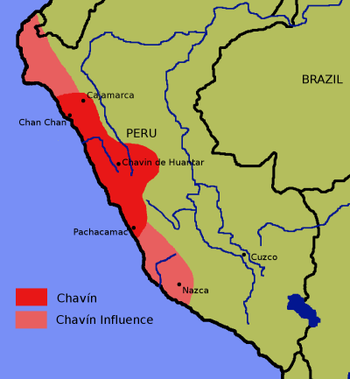 منطقة التشاڤين، وكذلك المناطق التي أثر فيها التشاڤين. | |||||||
| المكانة | حضارة | ||||||
| العاصمة | چاڤين ده هوانتار | ||||||
| الحقبة التاريخية | قبل كلومبس | ||||||
• تأسست | 900 ق.م. | ||||||
• انحلت | 200 ق.م. | ||||||
| |||||||
تشاڤين Chavín كانت ثقافة ازدهرت في مرتفعات الأنديز الشمالية في پيرو من 900 ق.م. إلى 200 ق.م. وقد مدوا نفوذهم إلى حضارات أخرى على طول الساحل.[1][2] وكان التشاڤين يتواجدون في وادي موسنا حيث يلتقي نهرا موسنا وهواچكسا. وهذه المنطقة ترتفع 3150 متراً فوق سطح البحر وتضم مناطق سكنى كويچوا, جالكا وپونا.[3]
أكثر المواقع الأثرية شهرة من عصر تشاڤين هو چاڤين ده هوانتار، الواقع في مرتفعات الأنديز شمال ليما. ويُعتقد أنه بُني حوالي 900 ق.م. وكان مركزاً دينياً وسياسياً لشعب چاڤين.[3] وقد أقرته اليونسكو موقعاً للتراث العالمي.
الفن
ثقافة تشافين تمثل أول ثقافة معترف بها على نطاق واسع في جبال الانديز. ويمكن تقسيم فن تشافين إلى مرحلتين : الأولى "معبد جديد" (500-200 ق م ج). الدراسة العامة لخزف تشافين فيما يتعلق بالشكل تكشف عن نوعين من الأوعية: نوع منحوت متعدد الأوجه ونوع مطلي كروي.[4] ومن ناحية النمط، فإن أشكال فن چاڤين تستخدم بكثافة تقنية تنافس الكونتور. وهذا الفن عن عمد صعب التفسير والفهم، إذ أنه كان المقصود منه أن يقرأه كبار كهنة ديانة الچاڤين، الذين كان باستطاعتهم فهم التصاميم المقدسة شديدة التعقيد. نصب رايموندي هو أحد الأمثلة الرئيسية على هذه التقنية.
الانجازات
دائرة النفوذ
وجود الصفوة
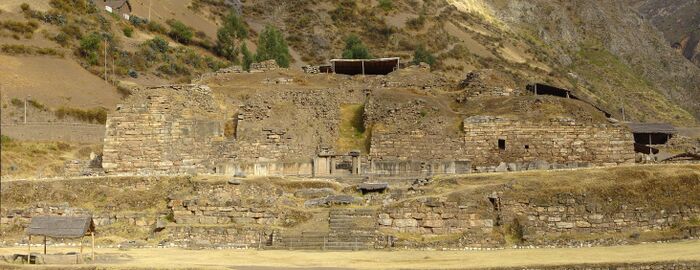
معرض
The sandeel monolithic has a length of 5 meters and represents a Chavín deity. It is located in the Ancient Temple in Chavín de Huantar.
Tenon head embedded in one of the walls of the temple of Chavín de Huantar.
The ceremonial centre of Kuntur Wasi, according to the latest archaeological research would be an prechavín expression associated to felínico Chavín cult. Cajamarca Region.
Remains of Pacopampa, another prechavín expression of Formative stage period but remained an important ceremonial centre like Chavín de Huantar, also located in the Cajamarca Region.
Model of the archaeological site of Chavín de Huantar.
The llama was the main representative of Chavín livestock.
انظر أيضاً
الهامش
- ^ Burger, Richard L. 2008 "Chavin de Huantar and its Sphere of Influence", In Handbook of South American Archeology, edited by H. Silverman and W. Isbell. New York: Springer, pp. 681-706
- ^ Burger, Richard L., and Nikolaas J. Van Der Merwe (1990). "Maize and the Origin of Highland Chavín Civilization: An Isotopic Perspective", American Anthropologist 92(1):85-95.
- ^ أ ب Burger (1992), Chavin and the Origins of Andean Civilization
- ^ Tello, Julio C. (1943) "Discovery of the Chavín Culture in Peru", American Antiquity 9(1, Countries South of the Rio Grande):135-160.
المراجع
- Bennett, Wendell C. (1943) "The Position of Chavin in Andean Sequences", Proceedings of the American Philosophical Society 86(2, Symposium on Recent Advances in American Archeology):323-327.
- Burger, Richard L. and Nikolaas J. Van Der Merwe. "Maize and the Origin of Highland Chavin Civilization: An Isotopic Perspective", American Anthropologist 92, 1 (1990), [85-95].
- Burger, Richard L. Chavin and the Origins of Andean Civilization. New York: Thames and Hudson, 1992.
- Burger, Richard L. 2008 "Chavin de Huantar and its Sphere of Influence", In Handbook of South American Archeology, edited by H. Silverman and W. Isbell. Springer, New York. Pages 681-706
- Burger, Richard 1992 "Sacred Center at Chavin de Huantar". In The Ancient Americas: Art from Sacred Landscapes. Chicago: Art Institute of Chicago. Art Institute of Chicago, and Museum of Fine Arts, Houston
- Druc, Isabelle C. 2004 "Ceramic Diversity in Chavín De Huantar, Peru". Latin American Antiquity 15(3):344-363
- Kanåo, Chiaki. 1979 The Origins of the Chavâin Culture. Washington, D.C: Dumbarton Oaks, Trustees for Harvard University.
- Kembel, Silvia Rodriquez and John W. Rick. 2004 Building Authority at Chavin de Huantar: Models of Social Organization and Development in the Initial Period and Early Horizon. In Andean Archaeology. Malden, Massachusetts: Blackwell Pub
- Lothrop, S. K. "Gold Artifacts of Chavin Style" Society for American Anthropology 16, 3 (1951), [226-240]
- Miller, George R. and Richard L. Burger. "Our Father the Cayman, Our Dinner the Llama: Animal Utilization at Chavin de Huantar, Peru", American Antiquity 60, 3 (1995). [421-458]
- Tello, Julio C. "Discovery of the Chavin Culture in Peru", American Antiquity 9, 1 (1943), [135-160], As you can see the Chavin influenced many other civilizations!
وصلات خارجية
- History Chavin culture
- (بالإسپانية) Peru Cultural website
- Minnesota State University e-museum
- Chavín de Huántar Digital Media Archive (creative commons-licensed photos, laser scans, panoramas), data from a Stanford University/CyArk research partnership (see Exploring Chavín de Huántar link above for additional contextual information)
- Chavín Project with a bibliography and external links
- Chavín Culture
